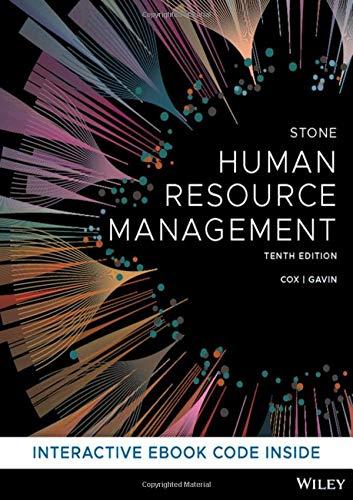The HR manager must identify those external influences that will affect the organisation and the management of
Question:
The HR manager must identify those external influences that will affect the organisation and the management of its human resources. Some of the major influences existing outside of the organisation include the following.
- Political. Political ideologies regarding human resources can range from an interventionist approach where government regulation of HRM is comprehensive - to one of minimal involvement. Specifically, political attitudes towards business, unions, management rights, strikes, secondary boycotts and enterprise bargaining can differ markedly - federally, from state to state and internationally.
- Legal. Laws and regulations regarding hours of work, holidays, equal employment opportunity (EEO), affirmative action, sexual harassment, workers' compensation, privacy, health and safety, fringe benefits and terminations clearly affect HRM.
- Environmental. Government and community concerns regarding environmental issues - such as energy conservation, workplace beautification and environmental pollution - directly or indirectly affect job design, employee orientation and training, health and safety, industrial relations and the image of an organisation as an employer.
- Technological. The level of technological advancement and the rate of technological change affect job design, recruitment, selection, training, motivation, remuneration, health and safety, job security and industrial relations. For example, sales representatives using mobile devices now work from home and spend more time selling instead of wasting time commuting to the office. Similarly, computer networks have eroded traditional workplace hierarchies. Networks mean junior employees can join immediate online discussions with senior executives (where they are judged more on what they say than on where they sit on the corporate ladder). More and more the emphasis is on the application of knowledge and not physical exertion. Many agricultural and industrial jobs, for example, have become knowledge jobs. Factories and farms are operated using computer software instead of manual labour. In the United States, two million clerical jobs have been lost since 2007 because of new computing technologies. Pay rates in many of the fast-growing occupations (e.g. fast food) are also lower than the jobs they are replacing (called technologically driven downwards mobility). \({ }^{241}\)
The new economy is a knowledge economy calling for new skills, new ways of working and new organisational structures. Organisations are shedding employees who are not core to their business success and using online marketplaces (such as www.freelancer.com.au) to find people prepared to bid for work. Workers, as a result, are becoming more like self-employed entrepreneurs. \({ }^{242}\) As traditional jobs disappear (or become more insecure) being 'connected' via social networking sites (such as LinkedIn) will be critical to career success. \({ }^{243}\) Social technologies, as a result, are now an essential part of how people work and interact. \({ }^{244}\) According to the Future of Talent Institute's Kevin Wheeler, 'We are . . . rapidly moving into a society where most of us will work primarily for ourselves for the majority of our careers' \({ }^{245}\)
- Cultural. Historical background, ideologies, values, norms and language all influence employee views on the role and importance of HRM, EEO, job titles, HRD and other aspects of HRM such as job design, remuneration, HRD, motivation and employee communication. Research indicates that the primary motivation for Chinese and Indian workers is to make money, for Japanese workers it is a commitment to the organisation, and for Taiwanese it is career progression and development. \({ }^{246}\) Cross-cultural studies also suggest that performance-based pay is a poor fit for some cultures. \({ }^{247}\)
- Demographic. The nature of the human resources available to the organisation in terms of the numbers, geographical distribution, age, sex, literacy, skill and education levels of the population has an effect on HRM. Ageing populations have spurred organisations to automate and change their remuneration practices; Japan's ageing society, for example, has stimulated Japanese firms to aggressively increase their expenditures on the development of robotics. \({ }^{248}\)
- Social. Changing values and attitudes towards issues such as dress, education, work, minorities, unions, management, social mobility, status, rewards, health and safety, job security, quality of life, employee privacy, gender roles, LGBTQIA rights and widening wealth inequalities affect every aspect of HRM. .........
DISCUSSION QUESTIONS
1 Which theory of motivation best describes Ella and Lyn's attitudes?
2 Would you prefer to be a freelancer or a permanent full-time employee? Why?
3 What challenges will employees face in the new gig economy? How would you propose to deal with them?
Step by Step Answer:

Human Resource Management
ISBN: 9780730385356
10th Edition
Authors: Raymond J. Stone, Anne Cox, Mihajla Gavin





